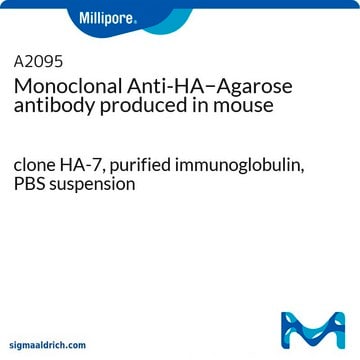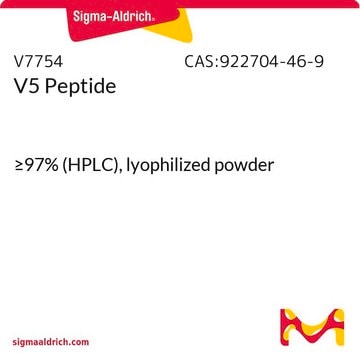11666975001
Roche
HA Peptide
9-amino acid synthetic peptide from hemagglutinin (HA) of an influenza virus
Synonym(s):
peptide
Sign Into View Organizational & Contract Pricing
All Photos(1)
About This Item
UNSPSC Code:
23201100
Recommended Products
Assay
95% (HPLC)
form
lyophilized
packaging
pkg of 5 mg
manufacturer/tradename
Roche
storage temp.
−20°C
Related Categories
General description
HA (hemagglutinin) is a surface glycoprotein, expressed by influenza virus.
Application
HA Peptide has been used in the following :
- Protein purification from Baculovirus infected cells.
- Affinity chromatography.
- Chromatin immunoprecipitation.
Biochem/physiol Actions
HA (hemagglutinin) protein is responsible for the infectivity of human influenza by inducing the production of neutralizing antibodies. HA mediates viral attachment to the surface of oligosaccharide receptors (at sialic acid terminal). HA contains conserved cross-reactive antigenic determinants, which is predicted to stimulate cross-protective antibodies.
Quality
- Purity: =95% (HPLC)
- Function test: Competitive ELISA, using Anti-HA-coated microplate to measure free HA Peptide inhibition of HA-peroxidase binding with detection by ABTS.
Reconstitution
Add 5 ml TBS to get a final concentration of 1 mg/ml.
Rehydrate for at least 10 minutes.
Rehydrate for at least 10 minutes.
Other Notes
For life science research only. Not for use in diagnostic procedures.
Storage Class Code
11 - Combustible Solids
WGK
WGK 1
Flash Point(F)
Not applicable
Flash Point(C)
Not applicable
Certificates of Analysis (COA)
Search for Certificates of Analysis (COA) by entering the products Lot/Batch Number. Lot and Batch Numbers can be found on a product’s label following the words ‘Lot’ or ‘Batch’.
Already Own This Product?
Find documentation for the products that you have recently purchased in the Document Library.
Customers Also Viewed
Physical and genetic associations of the Irc20 ubiquitin ligase with Cdc48 and SUMO.
Richardson A, et al.
PLoS ONE, 8(10), e76424-e76424 (2013)
R J Riese et al.
Immunity, 4(4), 357-366 (1996-04-01)
Destruction of li by proteolysis is required for MHC class II molecules to bind antigenic peptides, and for transport of the resulting complexes to the cell surface. The cysteine protease cathepsin S is highly expressed in spleen, lymphocytes, monocytes, and
Spt10 and Swi4 control the timing of histone H2A/H2B gene activation in budding yeast.
Eriksson P R, et al.
Molecular and Cellular Biology, 31(3), 557-572 (2011)
The degradation pathway of the mitophagy receptor Atg32 is re-routed by a posttranslational modification.
Levchenko M, et al.
PLoS ONE, 11(12), e0168518-e0168518 (2016)
Cytoplasmic ATXN7L3B interferes with nuclear functions of the SAGA deubiquitinase module.
Li W, et al.
Molecular and Cellular Biology (2016)
Our team of scientists has experience in all areas of research including Life Science, Material Science, Chemical Synthesis, Chromatography, Analytical and many others.
Contact Technical Service













